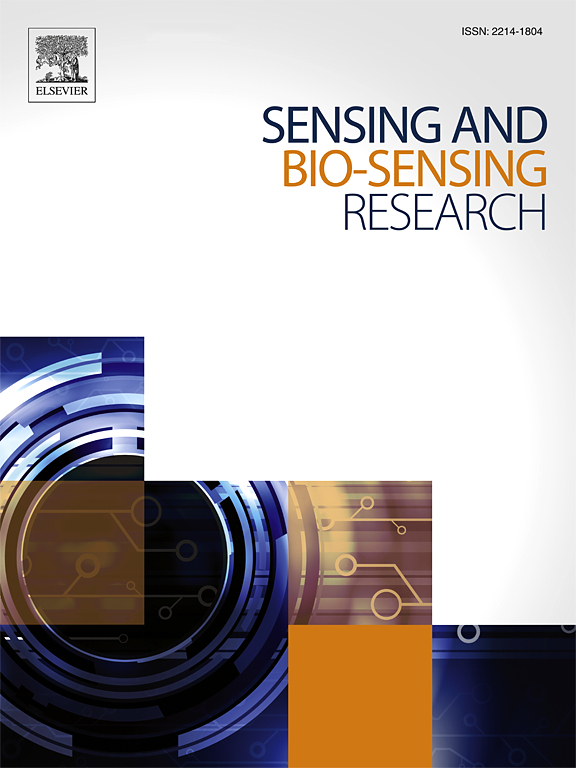绿色合成的花状银纳米颗粒作为早产儿母乳中蛋白质定量的比色生物传感器
IF 4.9
Q1 CHEMISTRY, ANALYTICAL
引用次数: 0
摘要
本研究利用绿色合成技术开发的一种生物传感器,利用花状淀粉基纳米结构检测母乳中的蛋白质。目标包括使用比色传感器方法对母乳中的蛋白质水平进行定量的绿色合成花状纳米颗粒。以玉米淀粉为还原剂合成纳米银。利用紫外可见分光光度法(UV-vis)、傅里叶变换红外光谱(FTIR)、x射线衍射(XRD)、透射电子显微镜(TEM)和拉曼光谱等多种分析技术对纳米颗粒进行了表征。比色检测包括观察AgNPs与蛋白质在波长为280 nm的紫外光刺激下的相互作用。这种反应产生了一种可见的颜色变化,根据蛋白质浓度的不同,颜色从蓝色到紫色不等。该方法可检测母乳中蛋白质含量在3.4 ~ 21.77 g/L范围内,相关值为0.9847。本研究强调了利用玉米淀粉合成绿色纳米颗粒的潜力,并强调了AgNPs在开发母乳蛋白检测灵敏生物传感平台中的应用。本文章由计算机程序翻译,如有差异,请以英文原文为准。

Green-synthesized flower-shaped silver nanoparticles as a colorimetric biosensor for protein quantification in preterm breast milk
This study utilized a biosensor developed through green synthesis employing flower-shaped starch-based nanostructures for the detection of protein in breast milk. The objectives included the green synthesis of flower-shaped nanoparticles using a colorimetric sensor approach to quantify the protein levels in breast milk. Cornstarch was used as a reducing agent to synthesize silver nanoparticles (AgNPs). The nanoparticles were characterized using several analytical techniques, including UV–visible spectrophotometry (UV–vis), Fourier Transform Infrared Spectroscopy (FTIR), X-ray Diffraction (XRD), Transmission Electron Microscopy (TEM), and Raman Spectroscopy. The colorimetric detection involved observing the interactions between AgNPs and proteins under UV light stimulation at a wavelength of 280 nm. The reaction produced a visible color change, ranging from blue to purple, depending on the protein concentration. This method enabled the detection of protein levels in breast milk within the range of 3.4–21.77 g/L, demonstrating a high correlation value of 0.9847. This research highlights the potential of utilizing corn starch in green nanoparticle synthesis and emphasizes the application of AgNPs in developing sensitive biosensing platforms for breast milk protein detection.
求助全文
通过发布文献求助,成功后即可免费获取论文全文。
去求助
来源期刊

Sensing and Bio-Sensing Research
Engineering-Electrical and Electronic Engineering
CiteScore
10.70
自引率
3.80%
发文量
68
审稿时长
87 days
期刊介绍:
Sensing and Bio-Sensing Research is an open access journal dedicated to the research, design, development, and application of bio-sensing and sensing technologies. The editors will accept research papers, reviews, field trials, and validation studies that are of significant relevance. These submissions should describe new concepts, enhance understanding of the field, or offer insights into the practical application, manufacturing, and commercialization of bio-sensing and sensing technologies.
The journal covers a wide range of topics, including sensing principles and mechanisms, new materials development for transducers and recognition components, fabrication technology, and various types of sensors such as optical, electrochemical, mass-sensitive, gas, biosensors, and more. It also includes environmental, process control, and biomedical applications, signal processing, chemometrics, optoelectronic, mechanical, thermal, and magnetic sensors, as well as interface electronics. Additionally, it covers sensor systems and applications, µTAS (Micro Total Analysis Systems), development of solid-state devices for transducing physical signals, and analytical devices incorporating biological materials.
 求助内容:
求助内容: 应助结果提醒方式:
应助结果提醒方式:


